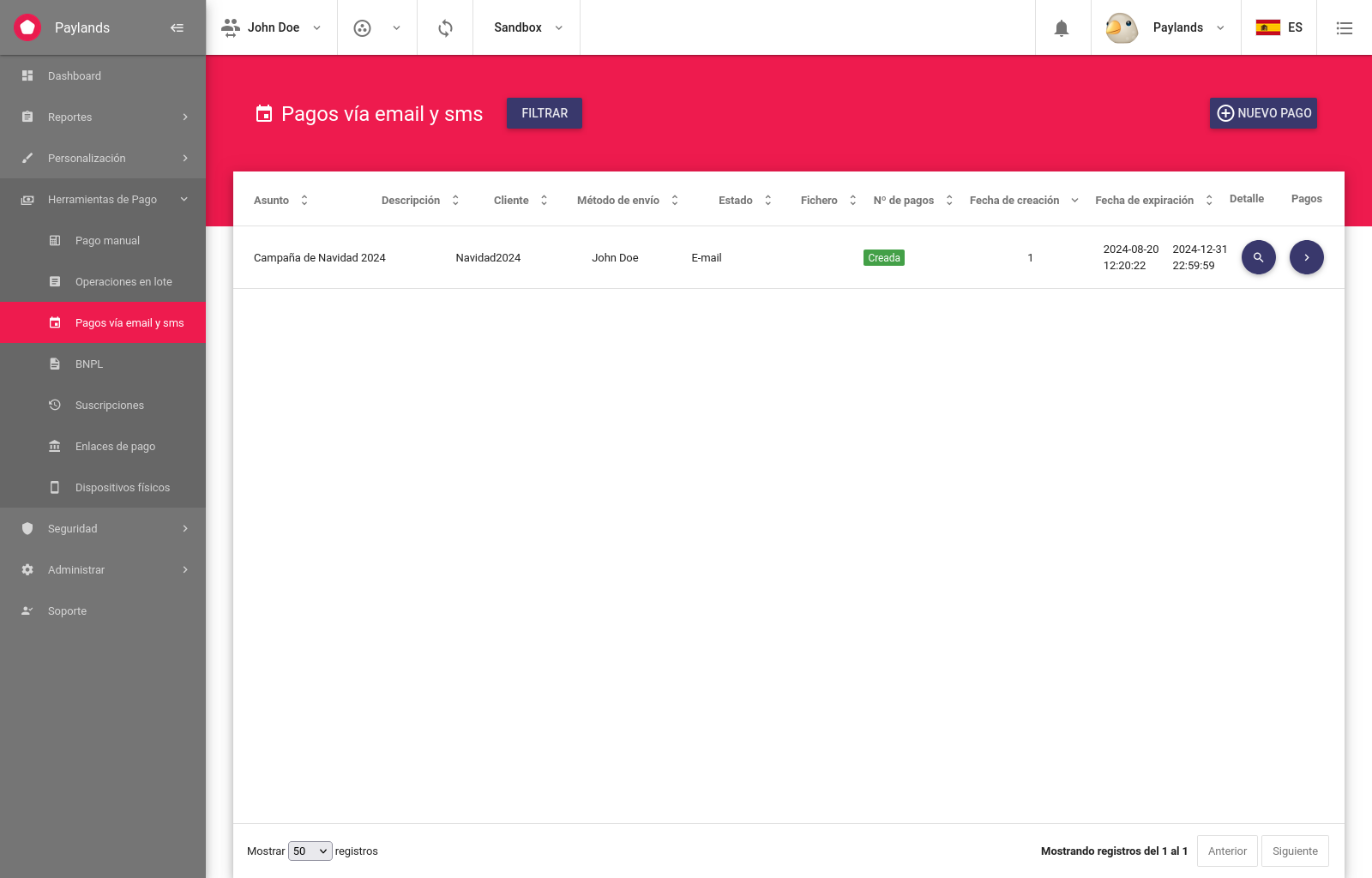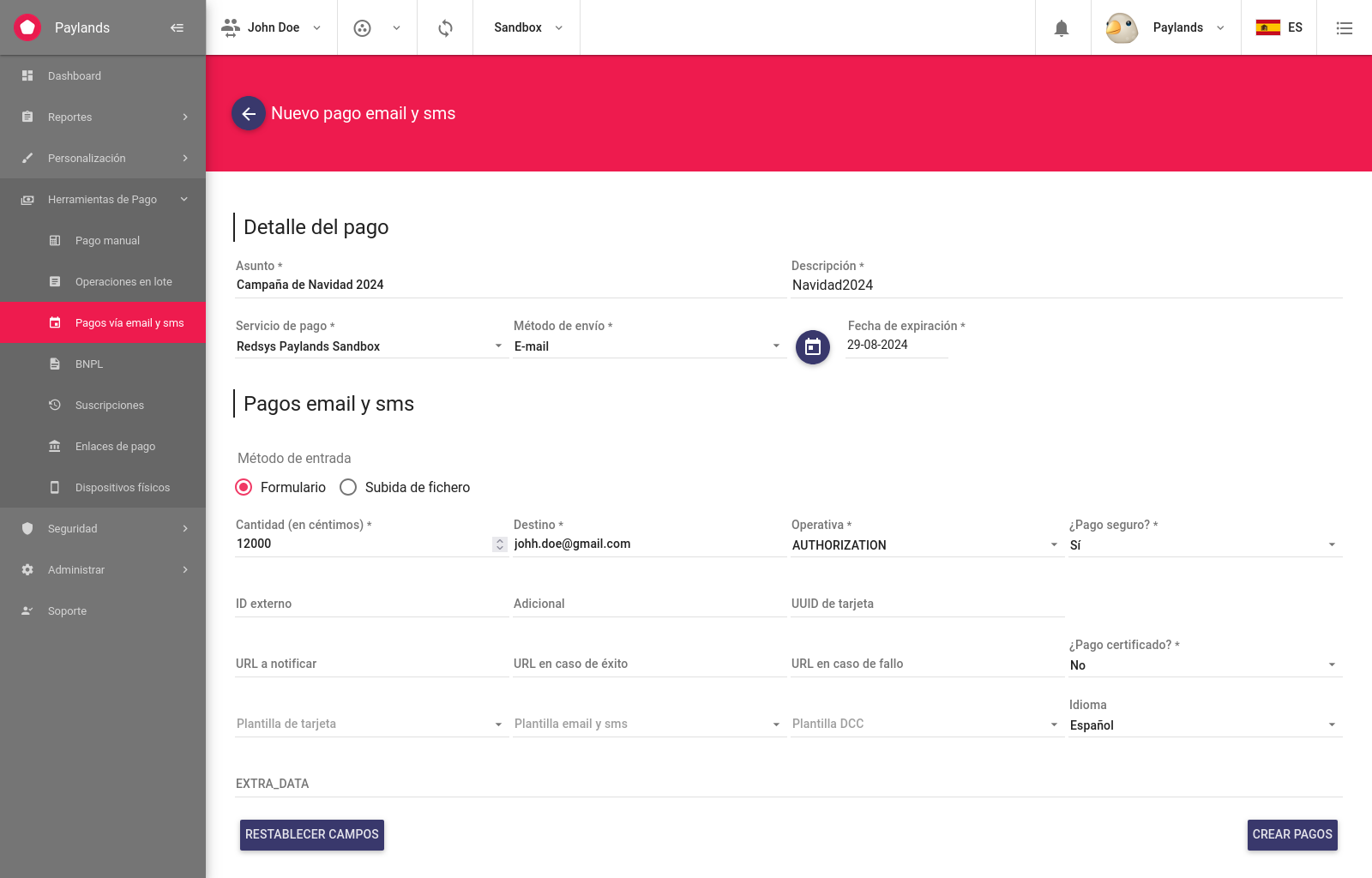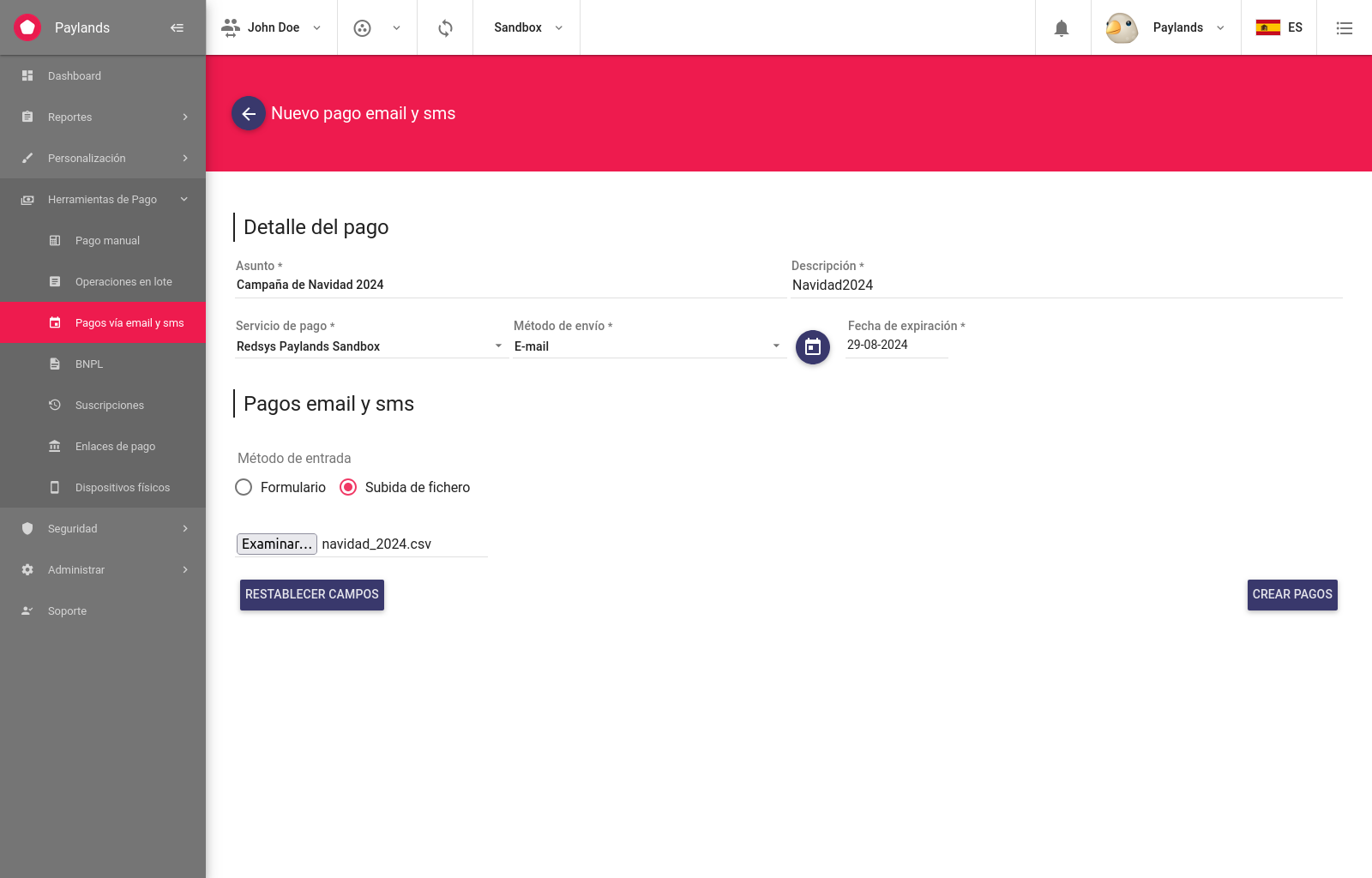Payments via email and SMS
Paylands offers the possibility of sending payment links both by email and SMS so that the user can make the payment at the moment it is available. To do this, simply upload a CSV file through our platform to send payment links to users, eliminating the need for an infrastructure to manage payments.
For each payment to be made, it will be necessary to indicate the amount to be paid and the recipient's email or phone number, as well as the subject of the email or SMS, among others. When the file is uploaded, all shipments will be carried out, which will be grouped in order to keep track of how many have been paid and which have not. As users pay, the status of the associated transactions will be updated.

Operation through the panel
This functionality is accessible only through the Paylands panel in section "Herramientas de pago" > "Pagos vía email y sms". This section lists the listings of recently initiated payments. To create a new payment, click the New Payment button. The form accepts the creation of a single payment or a CSV file with a list of payments.

All the fields that can be configured to trigger one or more payments are described below:
Payment detail.
- Subject: Subject of the email or title of the SMS that the user will receive.
- Description: Internal description of the campaign.
- Payment service: Payment service to be used for the payment.
- Sending method: Email, SMS or manual. If manual is selected, the links will be generated but will not be sent to the users.
- Expiration date: The date after which the payment link will no longer be valid.
Email and sms payments
- Method of entry: Form for a single shipment or File Upload for uploading a CSV file.
- Amount: Amount to be charged in cents.
- Destination: The email or mobile number of the recipient if it is SMS. If a telephone number is indicated, it must contain the prefix (+34 for Spain). If the sending method is manual, the format is free.
- Operational: AUTHORIZATION or DEFERRED. Determines whether or not the amount collected is settled the following day, respectively.
- Secure payment: Indicates whether the 3D Secure process will be carried out to authenticate the transaction.
- External ID: External ID that identifies the customer making the payment.
- Additional: Free field to be returned in the payment notification.
- CardUUID: If the card is indicated, the user will not need to re-enter it. Field "Pago seguro" must be "Sí".
- URL to notify: URL of the merchant that will receive the payment notification after the payment is completed.
- URL in case of success: URL to which the customer will be redirected in case of success.
- URL in case of failure: URL to which the customer will be redirected in case of error.
- Certified payment: Indicates whether the sending of the link will be certified or not*.
- Card Template: Allows to select a template from the screen in which the user enters his card data.
- MoTo Template: Allows to select the template that formats the email/sms.
- DCC Template: Allows to select the template where the user selects the currency to be used if the DCC is active.
- Language: Indicates the language to be shown to the recipient.
- Extra data: Allows to manually indicate the field
extra_datawhen generating the payment order.
* If the campaign is processed by SMS or Email, the link reception/opening certificate can be activated, which allows to check if the user has received the SMS/email or has accessed the payment link.
By selecting File upload you will be able to upload a file with multiple recipients by configuring an amount and sending method for each of them.

Structure of the payment file.
To launch sending multiple payment links simultaneously, a CSV file must be uploaded, which is a text document whose first line contains the header and the rest of the lines the data of each of the payments. This is its structure:
| Header | Type | Required | Description |
|---|---|---|---|
| AMOUNT | Integer | Yes | Amount to charge in cents. |
| OPERATIVE | String | Yes | AUTHORIZATION or DEFERRED. Determines whether the charged amount is settled the next day or not, respectively. |
| DESTINATION | String | Yes | The email or mobile number of the recipient if it's an SMS. If a phone number is provided, it must include the country code (e.g., +34 for Spain). If the sending method is manual, the format is free. |
| SECURE | String | Yes | Accepted values: true/false. Indicates whether the 3D Secure process will be carried out to authenticate the transaction. |
| CUSTOMER_EXT_ID | String | No | External ID that identifies the customer making the payment. |
| SOURCE_UUID | String | No | If the UUID of the card is provided, the user will not need to re-enter it. It is mandatory that the "SECURE" header is "true". |
| ADDITIONAL | String | No | Free field that will be returned in the payment notification. |
| URL_POST | String | No | URL of the merchant that will receive the payment notification once it is completed. |
| URL_OK | String | No | URL to which the customer will be redirected in case of success. |
| URL_KO | String | No | URL to which the customer will be redirected in case of error. |
| CARD_TEMPLATE | String | No | Allows selecting a template for the screen where the user enters their card details. |
| MOTO_TEMPLATE | String | No | Allows selecting the template that formats the email/SMS. |
| DCC_TEMPLATE | String | No | Allows selecting the template where the user chooses which currency to use if DCC is active. |
| CERTIFIED | String | No | true/false. Indicates whether the email or SMS will be certified. |
| LANGUAGE | String | No | Indicates the language that will be displayed to the recipient. Example: es |
| EXTRA_DATA | String | No | extra_data fields separated by semicolons. Subkeys will be nested using a period. For example, to indicate the cof RECURRING, the value should be specified as cof.reason:RECURRING |
Values are delimited with a comma: "SECURE". Optional headers containing no value can be omitted. Null or empty values are indicated by leaving a gap between commas. An example of a CSV is as follows:
AMOUNT,OPERATIVE,DESTINATION,SECURE,SOURCE_UUID,CUSTOMER_EXT_ID,ADDITIONAL,URL_POST,URL_OK,URL_KO,CARD_TEMPLATE,MOTO_TEMPLATE,DCC_TEMPLATE,CERTIFIED,LANGUAGE
12035,AUTHORIZATION,+34666554411,false,,user_1234,additional_info_1234,http://google.es/notification,http://google.es/ok_payment,http://google.es/ko_payment,,90895BE4-F614-447A-AE7F-082B248FE3A3,,false,es
In the example, the order will be created for a non-secure payment of 120.35€, associated to the customer 'user_1234'. The field 'SOURCE_UUID' has no value because it has been left empty.
Download receipt certificate
You can download the receipt certificate of a payment through the panel, in the payment detail. Available for email and SMS delivery.
Download link opening certificate
You can download the certificate of opening of the payment link of a payment through the panel, in the payment detail. Available for SMS delivery.
Receipt/opening certificates will only be available if certification (with CERTIFIED field set to true) was configured in the payment.
Custom fields in email and SMS templates.
The tool supports specific templates to be sent by SMS or e-mail. To use a custom template, you must send an e-mail to soporte@paylands.com.
Custom fields can be included in the email and SMS templates. To do so, the format to be sent, either from the panel form or by sending them via API must be:
key1:value1;key2:value2
The different fields must be separated by semicolons.
For example, sending in the additional field the following value:
name: Juan García; age: 28
In the email/sms template these values can be accessed as follows:
Welcome {{customFields.name}},
happy {{customFields.age}} years.